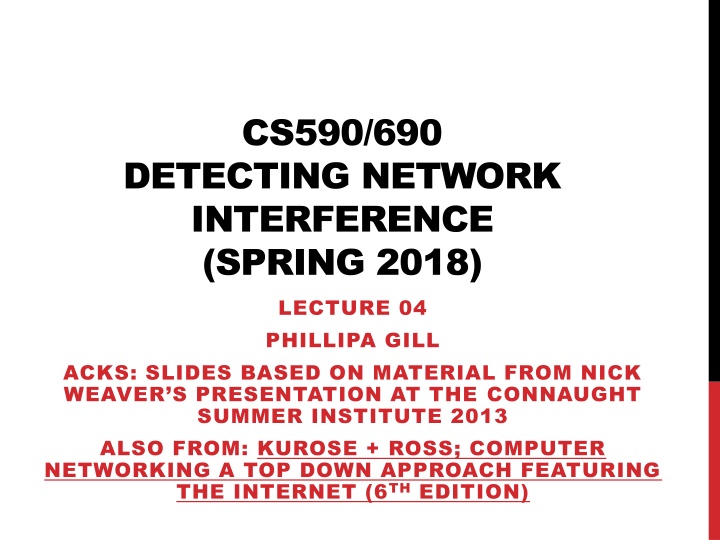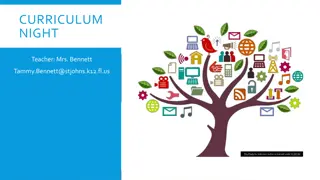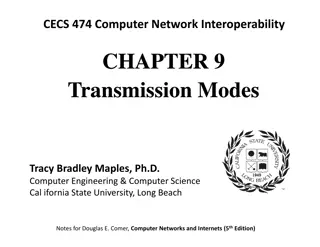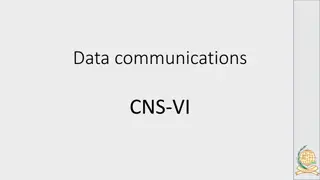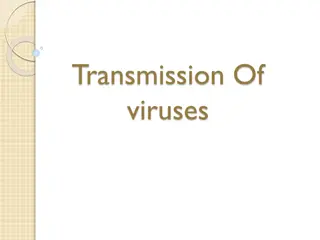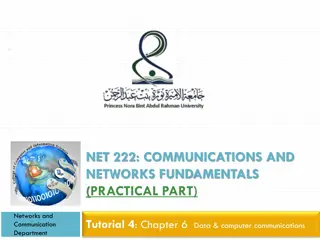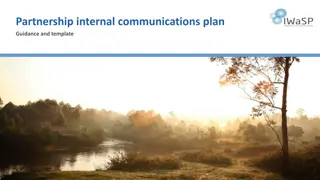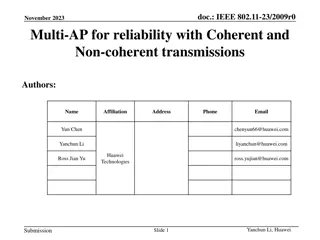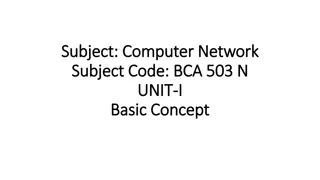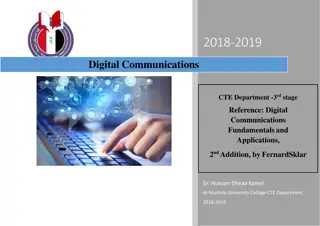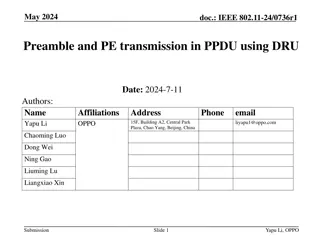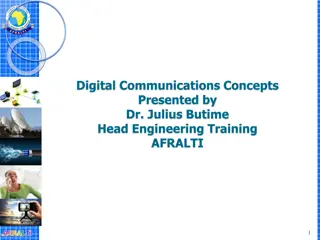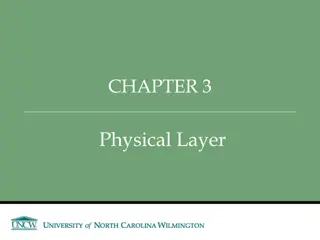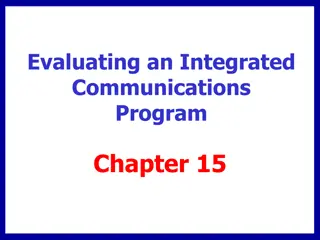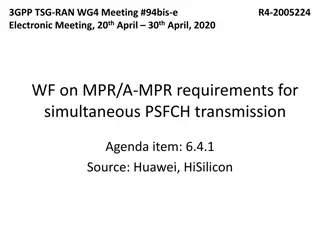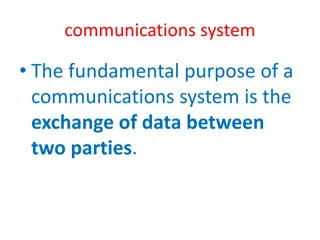Data Transmission Essentials in Computer Communications
Delve into the intricacies of data transmission as it unfolds between transmitters and receivers through various mediums like guided and unguided media. Explore simplex, half-duplex, and full-duplex transmission terminologies. Understand the differences between analog and digital waveforms, along with examples of periodic signals like sine waves and square waves. Gain insights into the fundamental aspects of data transmission to enhance your knowledge in computer communications.
Download Presentation

Please find below an Image/Link to download the presentation.
The content on the website is provided AS IS for your information and personal use only. It may not be sold, licensed, or shared on other websites without obtaining consent from the author.If you encounter any issues during the download, it is possible that the publisher has removed the file from their server.
You are allowed to download the files provided on this website for personal or commercial use, subject to the condition that they are used lawfully. All files are the property of their respective owners.
The content on the website is provided AS IS for your information and personal use only. It may not be sold, licensed, or shared on other websites without obtaining consent from the author.
E N D
Presentation Transcript
CS590/690 DETECTING NETWORK INTERFERENCE (SPRING 2018) LECTURE 04 PHILLIPA GILL ACKS: SLIDES BASED ON MATERIAL FROM NICK WEAVER S PRESENTATION AT THE CONNAUGHT SUMMER INSTITUTE 2013 ALSO FROM: KUROSE + ROSS; COMPUTER NETWORKING A TOP DOWN APPROACH FEATURING THE INTERNET (6THEDITION)
ADMINISTRATIVE NOTE Assignment 1 warm up Download/play with Wireshark Investigate Bro www.bro-ids.org Lots of tutorials here: https://www.bro.org/documentation/index.html Project + A1 info coming after today.
WHERE WE ARE Last time: TCP Resets for censorship Fingerprinting Reset Injectors (NDSS 2009 paper) On path vs. In path censorship Questions?
TEST YOUR UNDERSTANDING 1. What is the difference between an in-path and on-path censor? 2. What are the pros of each approach? 3. Cons? 4. What are the two race conditions that can occur with reset injectors? 5. What headers would you look at to ID a reset injector? 6. How would you localize an injector to a specific location in the network? 7. If the TCP reset occurs before the HTTP GET what can you say about the trigger? 8. After?
OVERVIEW Block IP addresses IP layer Disrupt TCP flows TCP (transport layer) Many possible triggers Block hostnames Today DNS (application layer) Disrupt HTTP transfers HTTP (application layer)
DNS NAME RESOLUTION EXAMPLE root DNS server 2 3 host at cis.poly.edu wants IP address for gaia.cs.umass.edu TLD DNS server 4 5 local DNS server dns.poly.edu iterated query: contacted server replies with name of server to contact I don t know this name, but ask this server 6 7 1 8 authoritative DNS server dns.cs.umass.edu requesting host cis.poly.edu gaia.cs.umass.edu 2-7 Application Layer
DNS: A DISTRIBUTED, HIERARCHICAL DATABASE Root DNS Servers org DNS servers edu DNS servers com DNS servers poly.edu DNS servers umass.edu DNS servers pbs.org DNS servers yahoo.com DNS servers amazon.com DNS servers 2-8 Application Layer
DNS: ROOT NAME SERVERS contacted by local name server that can not resolve name root name server: contacts authoritative name server if name mapping not known gets mapping returns mapping to local name server c. Cogent, Herndon, VA (5 other sites) d. U Maryland College Park, MD h. ARL Aberdeen, MD j. Verisign, Dulles VA (69 other sites ) k. RIPE London (17 other sites) i. Netnod, Stockholm (37 other sites) m. WIDE Tokyo (5 other sites) e. NASA Mt View, CA f. Internet Software C. Palo Alto, CA (and 48 other sites) 13 root name servers worldwide a. Verisign, Los Angeles CA (5 other sites) b. USC-ISI Marina del Rey, CA l. ICANN Los Angeles, CA (41 other sites) g. US DoD Columbus, OH (5 other sites) 2-9 Application Layer
TLD, AUTHORITATIVE SERVERS top-level domain (TLD) servers: responsible for com, org, net, edu, aero, jobs, museums, and all top-level country domains, e.g.: uk, fr, ca, jp Network Solutions maintains servers for .com TLD Educause for .edu TLD authoritative DNS servers: organization s own DNS server(s), providing authoritative hostname to IP mappings for organization s named hosts can be maintained by organization or service provider 2-10 Application Layer
DNS RECORDS DNS: distributed db storing resource records (RR) RR format:(name, value, type, ttl) type=A nameis hostname valueis IP address type=CNAME name is alias name for some canonical (the real) name www.ibm.comis really servereast.backup2.ibm.com valueis canonical name type=NS name is domain (e.g., foo.com) value is hostname of authoritative name server for this domain type=MX valueis name of mailserver associated withname 2-11 Application Layer
DNS PROTOCOL, MESSAGES query and reply messages, both with same message format 2 bytes 2 bytes msg header identification: 16 bit # for query, reply to query uses same # flags: query or reply recursion desired recursion available reply is authoritative identification flags # questions # answer RRs # additional RRs # authority RRs questions (variable # of questions) answers (variable # of RRs) authority (variable # of RRs) additional info (variable # of RRs) 2-12 Application Layer
DNS PROTOCOL, MESSAGES 2 bytes 2 bytes identification flags # questions # answer RRs # additional RRs # authority RRs name, type fields for a query questions (variable # of questions) RRs in response to query answers (variable # of RRs) records for authority (variable # of RRs) authoritative servers additional helpful info that may be used additional info (variable # of RRs) 2-13 Application Layer
DNS: CACHING, UPDATING RECORDS once (any) name server learns mapping, it caches mapping cache entries timeout (disappear) after some time (TTL) TLD servers typically cached in local name servers thus root name servers not often visited cached entries may be out-of-date (best effort name-to-address translation!) if name host changes IP address, may not be known Internet-wide until all TTLs expire update/notify mechanisms proposed IETF standard RFC 2136 2-14 Application Layer
OK SO NOW WE KNOW ABOUT DNS how can we block it! A few things to keep in mind No cryptographic integrity of DNS messages DNSSEC proposed but not widely implemented Caching of replies means leakage of bad DNS data can persist
BLOCKING DNS NAMES Can the censor pressure the registrar? Name blocked, forever
TYPES OF FALSE DNS RESPONSES DNS RESPONSE A 192.168.5.2 DNS RESPONSE A 127.0.0.1 159.106.121.75 DNS RESPONSE A 3rd Party DNS Server (8.8.8.8) NXDOMAIN DNS QTYPE A www.censored.com DNS Server (2.1.2.3) DNS RESPONSE A 1.2.3.5 (correct IP) Block page server (192.168.5.2) Home connection (2.1.2.4) This diagram assumes ISP DNS Server is complicit.
BLOCKING DNS NAMES Option A: get ISP resolver on board (Previous slide) Option B: On-path packet injection similar to TCP Resets Can be mostly countered with DNS-hold-open: Don t take the first answer but instead wait for up to a second Generally reliable when using an out of country recursive resolve E.g., 8.8.8.8 Can be completely countered by DNS-hold-open + DNSSEC Accept the first DNS reply which validates
READING FROM WEB Hold-On: Protecting Against On-Path DNS Poisoning H. Duan, N. Weaver, Z. Zhao, M. Hu, J. Liang, J. Jiang, K. Li, and V. Paxson. Idea: Once you receive a DNS packet, wait for a predefined hold-on period before accepting the result. DNSSEC is still vulnerable to these injected packets and does not make hold-on unneccessary Inject a reply with an invalid signature: client will reject Use active measurements to determine the expected TTL and RTT to the server.
LINK TO FOCI2014 TALK VIDEO https://www.usenix.org/conference/foci14/workshop- program/presentation/anonymous ^^^ This talk does a good job of overviewing the reading by anonymous.
NEXT TIME Filtering of Web requests at application layer.
